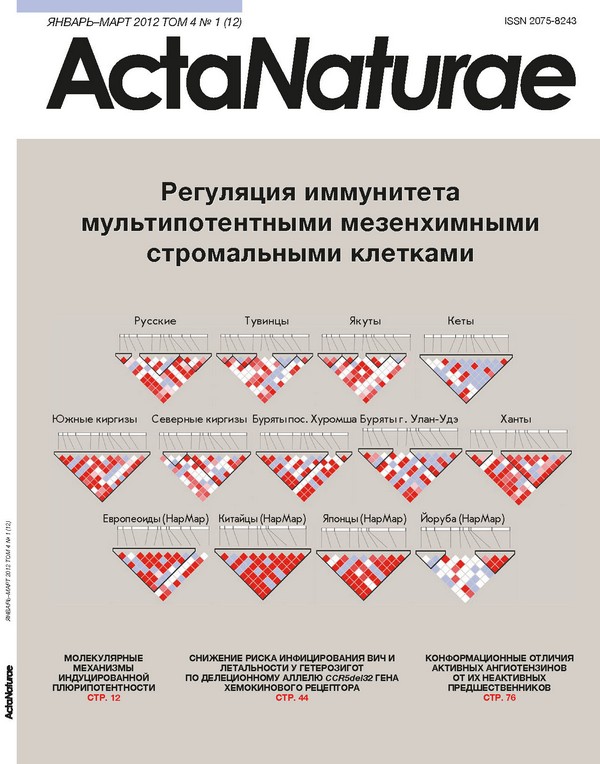Conformational Differences between Active Angiotensins and Their Inactive Precursors
- Authors: Solopova O.N.1, Pozdnyakova L.P.1, Varlamov N.E.1, Bokov M.N.1, Morozkina E.V.2, Yagudin Т.А.2, Sveshnikov P.G.1
-
Affiliations:
- Russian Research Center for Molecular Diagnostics and Therapy
- Bach Institute of Biochemistry, Russian Academy of Sciences
- Issue: Vol 4, No 1 (2012)
- Pages: 74-77
- Section: Research Articles
- URL: https://actanaturae.ru/2075-8251/article/view/10636
- DOI: https://doi.org/10.32607/20758251-2012-4-1-74-77
- ID: 10636
Cite item
Abstract
The peptide conformation in the context of a protein polypeptide chain is influenced by proximal amino acid residues. However, the mechanisms of this interference remain poorly understood. We studied the conformation of angiotensins 1, 2 and 3, which are produced naturally in a sequential fashion from a precursor protein angiotensinogen and contain an identical peptide core structure. Using the example of angiotensins 1, 2 and 3, it was shown that similar amino acid sequences may have significant conformational differences in various molecules. In order to assess the conformational changes, we developed a panel of high-affinity mouse monoclonal antibodies against angiotensins 1, 2 and 3 and studied their cross-reactivity in indirect and competitive ELISAs. It was found that the conformations of inactive angiotensin1 and the corresponding fragment of angiotensinogen are similar; the same is true for the conformations of active angiotensins 2 and 3, whereas the conformations of homologous fragments in the active and inactive angiotensins differ significantly.
Keywords
About the authors
O. N. Solopova
Russian Research Center for Molecular Diagnostics and Therapy
Author for correspondence.
Email: solopova@msn.com
Russian Federation
L. P. Pozdnyakova
Russian Research Center for Molecular Diagnostics and Therapy
Email: solopova@msn.com
Russian Federation
N. E. Varlamov
Russian Research Center for Molecular Diagnostics and Therapy
Email: solopova@msn.com
Russian Federation
M. N. Bokov
Russian Research Center for Molecular Diagnostics and Therapy
Email: solopova@msn.com
Russian Federation
E. V. Morozkina
Bach Institute of Biochemistry, Russian Academy of Sciences
Email: solopova@msn.com
Russian Federation
Т. А. Yagudin
Bach Institute of Biochemistry, Russian Academy of Sciences
Email: solopova@msn.com
Russian Federation
P. G. Sveshnikov
Russian Research Center for Molecular Diagnostics and Therapy
Email: solopova@msn.com
Russian Federation
References
- Kohler G., Milstein C. // Nature. 1975. V. 256. P. 495-497.
- Sveshnikov P.G., Malaitsev V.V., Bogdanova I.M., Solopova O.N. Vvedenie v molekulyarnuyu immunologiyu i gibridomnuyu tehnologiyu (Introduction into molecular immunology and hybridoma technology). M.: MSU, 2006.
- de Gasparo M., Catt K.J., Inagami T., Wright J.W., Unger T. // Pharmacol. Rev. 2000. V. 52. P 415-472.
- Boucher R., Demassieux S., Garcia R., Genest J. // Circ. Res. 1977. V. 41. P 26-29.
- WO2005/028510. Methods, Kits and Compositions for the Developments and Use of Monoclonal Antibodies Specific to Antigens of Low Immunogenecity. Patent USA. 2005.
- Sveshnikov P.G., Gorodetskaya S.B., Shemchukova O.B., Solopova O.N., Bokov M.N., Varlamov N.E., Ulianov A.M., Lyutova E.M., Kiselev V.I., Budarina S.O., Ashrafian L.A. // Molecular Medicine. 2009. V. 4. P. 45-50.
- Engvall E., Perlmann P. // Immunochemistry. 1971. V. 8. № 9. P 871-874.
- Engvall E., Jonsson K., Perlmann P. // Biochim. Biophys. Acta. 1971. V. 28. 251. № 3. P. 427-434.
- Jungbauer A., Tauer C., Reiter M., Purtscher M., Wenisch E., Steindl F., Buchacher A., Katinger H. // J. Chromatogr. 1989. V. 476. P. 257-268.
- Laemmli U.K. // Nature. 1970. V. 227. P 680-685.
- Klotz I.M. The Proteins / Eds Neurath H., Bailey K. N.Y.: Acad. Press. V. 1. 1953. P 727.
- Friguet B., Chaffotte A.F., Djavadi-Ohaniance L., Goldberg M.E. // J. Immunol. Methods. 1985. V. 77. P. 305-319.
- Clouston W.M., Evans B.A., Haralambidis J., Richards R.I. // Genomics. 1988. V. 2. Р 240-248.
Supplementary files







